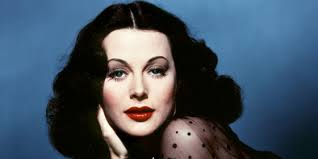Austrian actress Hedy Lamarr is one of the least remembered of the classic Hollywood beauty queens, but for moviegoers in the 1930s and 1940s her name conjured up visions of exotic glamour and mystery. The 100th, or possibly *101st, anniversary of Lamarr’s birth will be this Sunday. In this article, I will look at her film career and also celebrate her important contributions to science and technology.
*Note: There is some discrepancy over Lamarr’s actual birth year. Her son and her biographer put it at 1914, while other sources, such as the Encyclopedia Britannica, have it at 1913. There’s more here, if you’re interested.
Whatever the year, Lamarr was born Hedwig Eva Maria Kiesler on Nov. 9 in Vienna to a prominent banking family. German impresario Max Reinhardt gave Lamarr her start in films when she was only a teenager. Lamarr worked her way up from bit player and script girl and in 1933 she became an international sensation when she appeared in the Czech film, Extase. The marital drama featured Lamarr in the nude and in a notorious sex scene that was boundary pushing at the time, but seems really tame by 2014 standards.
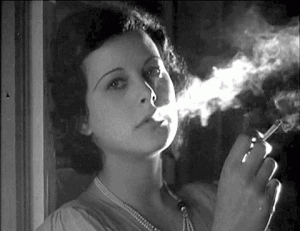
After a brief marriage, Lamarr was discovered in 1937 by MGM chief Louis B. Mayer, who gave her a new last name in honor of silent film actress Barbara La Marr. Lamarr’s first Hollywood film, Algiers, was a huge hit. Lamarr worked steadily for the next decade, but she was only ever an average actress. Her breathtaking beauty and exotic allure led producers to cast her as the femme fatale, but she was rarely asked to do more than look ravishing. She was the first choice to play Ilsa in Casablanca, but either she turned the role down or MGM executives would not let her out of her contract (stories differ on this matter). Her career declined after Samson and Delilah in 1949. She sometimes appeared on television, but in the next decades she led a mostly quiet life. She did briefly resurface in pop culture in 1974 when Harvey Korman played conniving lawyer Hedley Lamarr in the Western spoof, Blazing Saddles (Lamarr filed a lawsuit against Mel Brooks and it was settled out of court). Lamarr died of heart disease in 2000. Her ashes were spread in the Vienna Woods at her request.
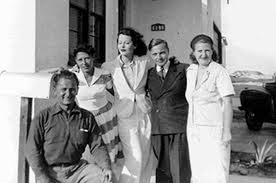
Lamarr’s lasting legacy will be her career as an inventor. Lamarr was always exceptionally talented in mathematics and while she was a movie star she enjoyed going into her “invention room” to get away from the stress of Hollywood. Lamarr’s most important invention is “spread spectrum” or “force-hopping” technology which she patented in 1942 with her Hollywood neighbor, composer George Antheil. The technology manipulates radio signals at irregular intervals so they form an unbreakable code. Lamarr and Antheil’s idea was to help radio-guided torpedoes reach their target during World War II, but the U.S. Navy did not adopt the technology until 1962. Lamarr and Antheil’s invention helped fuel the digital boom making cell phones and wireless technology.
Since Hedy’s invention is bringing you this internet signal, We’ll take a brief look at five Lamarr films that I’ve enjoyed through the years.
Algiers (1938, director John Cromwell)
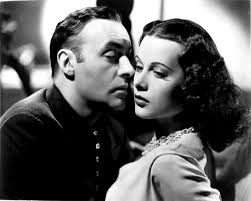
This was Lamarr’s first Hollywood film. It was a huge hit and implanted Lamarr’s exotic femme fatale persona in audiences’ minds. Algiers tells the story of jewel thief Pepe le Moko (Charles Boyer) as he hides out from the authorities in the Casbah. There he meets glamorous French tourist Gaby (Lamarr) and falls hopelessly in love. Algiers has had a lasting impact in pop culture: The doomed romance and North African location inspired Casablanca, and Boyer’s Gallic love-making style was spoofed by Looney Tunes creation Pepe le Pew. Amazon Prime; DVD.
Boom Town (1940, director Jack Conway)
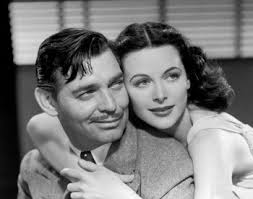
Clark Gable and Spencer Tracy were something of the Channing Tatum and Jonah Hill of the late 1930s and early 1940s. They teamed up for three successful films where Gable played off of his manly-man persona with Tracy as his schlubby, sensitive buddy. In Boom Town, they continued their bromance by playing Texas oilmen who were squabbling over black gold and the affections of a good girl played by Claudette Colbert and a conniving femme fatale played by Lamarr. DVD and video on demand.
Ziegfeld Girl (1941, director Robert Z. Leonard)
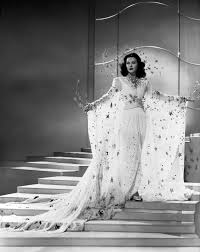
Lamarr stars as one of three women — the other two are Lana Turner and Judy Garland — who are vying for a spot in one of the legendary producer Florenz Ziegfeld’s Broadway shows. Lamarr plays a beautiful woman who is lured away for a time from her husband (Philip Dorn) by the bright lights of stardom. The undisputed highlight of the film is Garland singing, “I’m Always Chasing Rainbows,” but Lamarr has a very nice story arc of her own. For once, she gets to play a real person and she makes her character believable and sincere. DVD and video on demand.
H.M. Pullham, Esq. (1941, director King Vidor)
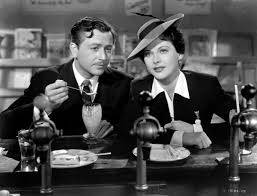
Once again, Lamarr shines when she is asked to play something other than a sex goddess. Here she is a working class woman who was madly in love with a Boston aristocrat (Robert Young) in her youth. This bittersweet film traces their relationship through flashbacks and interior monologues (many film scholars think Vidor’s directing style influenced Citizen Kane). DVD.
Samson and Delilah (1949, Cecil B. DeMille)

This was one of the first big budget, sword-and-sandal epics that would become so popular in the 1950s. It was a huge commercial and critical success in its day (it won Oscars for Best Art Direction and Best Costume Design), and it is still wildly entertaining today, basically because it’s so campy. None of the actor’s come out smelling like roses, but Lamarr, playing the Biblical bad girl Delilah, does exactly what is expected of her: She looks fabulous in the Edith Head costumes and seductively paws at every man that comes within her breathing space. Amazon Prime; DVD and video on demand.
Chime in with your favorite Lamarr performances in the comments.

